

Subscribe »
Touchstones
“Heathers” Blew Up the High-School Comedy
The 1989 cult classic ushered in a darker, weirder, more experimental era for teen movies.
Text by Naomi Fry



Supported by Tiffany & Co.
“Touchstones” is an ongoing interactive series in which New Yorker writers guide us through the works that shaped them as critics and as people.
In the course of the eighties, nothing formed my understanding of what it meant to be a teen-ager, and particularly an American teen-ager, more than the movies of John Hughes. I was an Israeli kid who occasionally, thanks to my dad’s job, spent time in the United States, and Hughes’s œuvre—especially “The Breakfast Club,” “Pretty in Pink,” and “Sixteen Candles”—served, for me, as both an anthropological document and a how-to guide. For American teen-agers, I learned, daily life was a battleground: their parents pushed them around or ignored them; their teachers were bored and boring; they were confused about sex, and even more so about love; race was rarely a problem (the American teen-ager was almost always white), but class, and especially money, was; and class and money translated into the chief issue seemingly dogging every American teen-ager’s life—high-school cliques, and one’s ability to break free of their constraints in order to discover who one really was.
No matter how difficult these issues were to deal with, however, teens were able to overcome them by the end of Hughes’s movies. No problem was unmanageable, no adversity insurmountable. The movies’ redemptive arc guaranteed that the burnout and the prom queen could set their conflicts aside—as could the rich guy and the poor girl, and the jock and the weirdo—and the result was a new, more perfect union, which was more often than not sealed with a kiss.
The Hughesian Ending
“Make a wish,” Jake tells Samantha in the last scene of “Sixteen Candles.” “It already came true,” she replies.
The constancy of this teen-movie template was likely why “Heathers”—directed by Michael Lehmann, written by Daniel Waters, and the feature-film début for both—came as such a shock. Though the movie was released in the States in 1989—where it was, for the most part, a critical hit, though a box-office flop—it had not come out in Israel, and I saw it only in 1990, which I spent in Seattle. That year, I had fashioned myself as a sophisticated outsider, and had begun going to see movies alone, as sophisticated outsiders tend to do. (Making friends was a little bit of a struggle.) And so I settled down alone in a cinematheque-style theatre to watch what I believed would be another Hughes-style comedy. “Heathers,” I imagined, would focus on two attractive young people, played by Winona Ryder and Christian Slater, who would, against the odds, fall in love, come to resist the cliquishness of their school—embodied by a trio of popular mean girls, all named Heather—and bring on an improved, quasi-utopian social order.
But about twenty-five minutes into the movie I experienced a strong cognitive dissonance: I watched as J.D. (Slater) and Veronica (Ryder) gave Heather Chandler, the cruellest, most powerful member of the Heathers, a poisonous concoction. Had they just killed her? A teen movie couldn’t include murders, could it?
It turned out that it could, and it did. In order to subvert Westerberg High’s oppressive hierarchy, J.D., with Veronica’s half-unwitting help, kills not only Heather Chandler but also Kurt and Ram—two popular, boorish football players—and the couple stage the murders as suicides to cover their tracks. At first, Veronica is enamored of the trenchcoat-wearing J.D. and his anti-establishment swagger. But soon enough she begins to chafe against his attempts to dominate her, and his increasing bloodlust. She breaks up with him and, after she discovers his intention to bomb the school, surprises him in Westerberg’s boiler room, where she manages to defuse explosives he has planted. In the movie’s climactic scene, Veronica looks on, deadpan, from the school’s front steps, as J.D. blows himself up, the cigarette she has placed in her mouth smoldering from the heat of the explosion. This was the “Heathers” alternative to an end-of-movie kiss.
It wasn’t exactly that “Heathers” contained no Hughesian influence. The types and tropes were all there—mean girls, jocks, bullying, upper-middle-class ennui, idiotic or abusive parents, delusional teachers, a bad-boy crush—but they were relentlessly amplified, turned into grotesques. The tone was arch, dripping with self-awareness
(“Dear diary, my teen-angst bullshit has a body count,”
Veronica scribbles in her journal); the script was full of nasty, snarky catchphrases (
“Fuck me gently with a chainsaw”
is, perhaps, especially memorable). The visual palette was garishly Technicolor, a teen dream made nightmare; the bodily fluids, from phlegm to vomit to blood, flowed. In short, “Heathers” seemed influenced as much by “Blue Velvet” as by “Sixteen Candles,” and it paved the way for an era of darker, edgier, more experimental teen comedies.
Hollywood High
“We really wanted to make the teen film to end all teen films,” Ryder said. Instead of putting an end to the genre, though, “Heathers” gave it new life.

“Fast Times at Ridgemont High” (1982)

“The Breakfast Club” (1985)

“Better Off Dead” (1985)

“Pretty in Pink” (1986)

“Heathers” (1989)

“Say Anything” (1989)

“Dazed and Confused” (1993)

“Clueless” (1995)

“Jawbreaker” (1999)

“Drop Dead Gorgeous” (1999)

“Election” (1999)

“Bring It On” (2000)

“Mean Girls” (2004)

“Superbad” (2007)

“Thoroughbreds” (2017)


Dark
Feel-Good
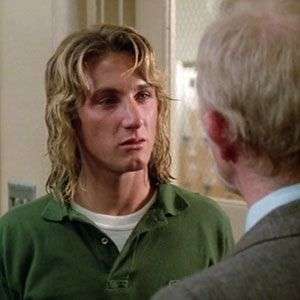

“Fast Times at Ridgemont High”
(1982)
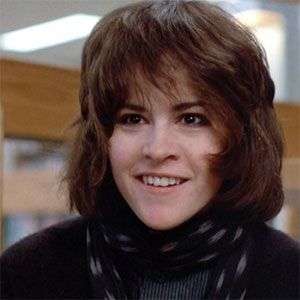

“The Breakfast Club”
(1985)
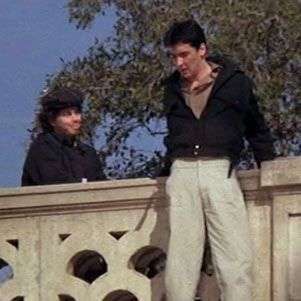

“Better Off Dead”
(1985)
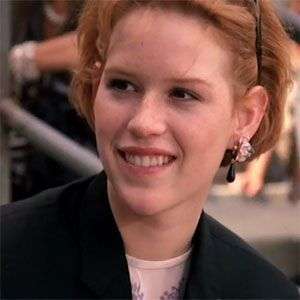

“Pretty in Pink”
(1986)
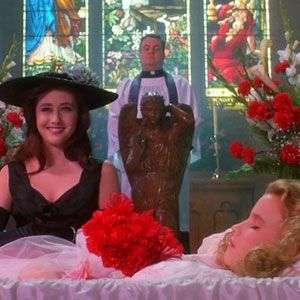

“Heathers”
(1989)
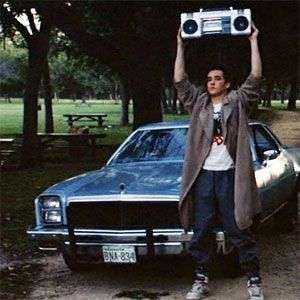

“Say Anything”
(1989)
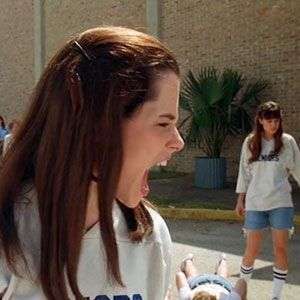

“Dazed and Confused”
(1993)


“Clueless”
(1995)
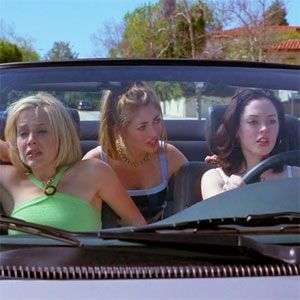

“Jawbreaker”
(1999)
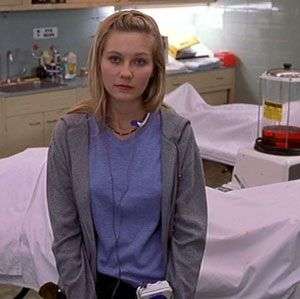

“Drop Dead Gorgeous”
(1999)
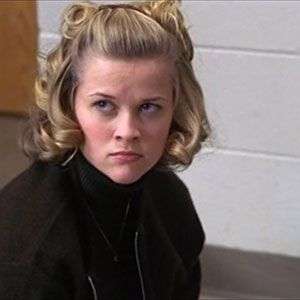

“Election”
(1999)
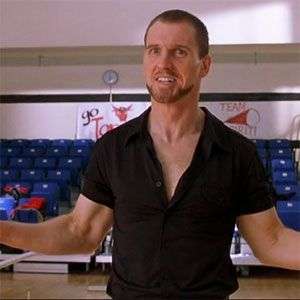

“Bring It On”
(2000)
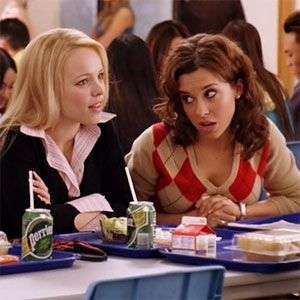

“Mean Girls”
(2004)


“Superbad”
(2007)
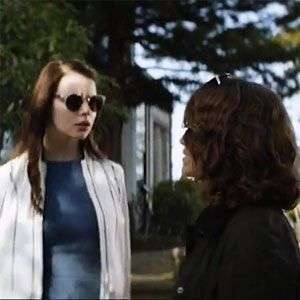

“Thoroughbreds”
(2017)
The devotion of “Heathers” to visual excess comes through, notably, in the movie’s sartorial language. The Heathers wear a uniform of exaggerated proportions, a cross between Leona Helmsley-style career-woman togs and fifties-schoolgirl cosplay: enormous-shouldered jackets, oversize Oxford shirts buttoned up to the top, large brooches and scrunchies (Heather Chandler’s is claimed like a talisman by Heather Duke, after the former’s death), short pleated skirts, bobby socks—all in bright Memphis Milano tones of red, turquoise, and yellow. The look is, by definition, too much. This is Queen Bee fashion, more menacing than stylish. We will impose our outsized taste on the world, it announces, and we’ll do so in lockstep.
Queen-Bee Fashion
The Heathers belong to an enduring tradition of leading ladies who gossip, backstab, and broadcast their social power through over-the-top outfits.
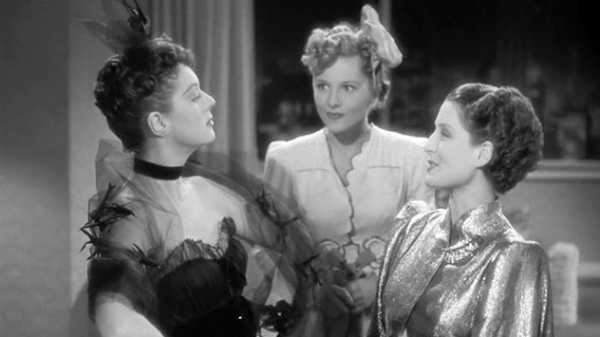
“The Women” (1939)
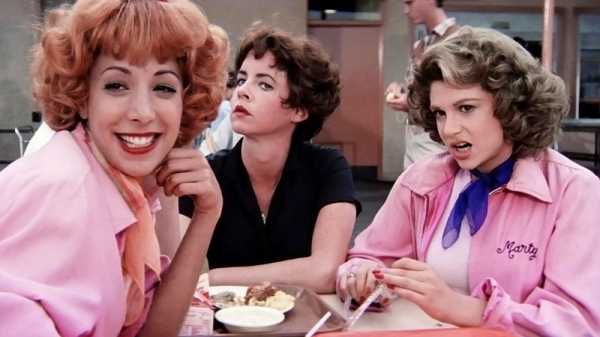
“Grease” (1978)
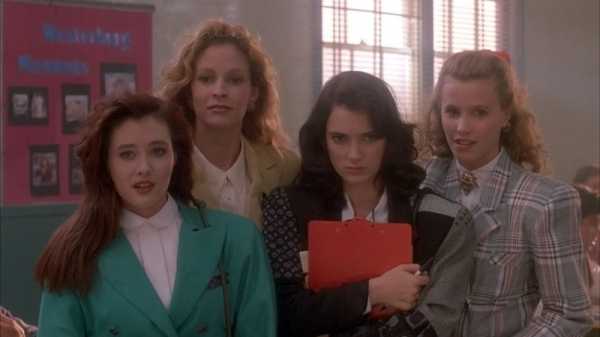
“Heathers” (1989)
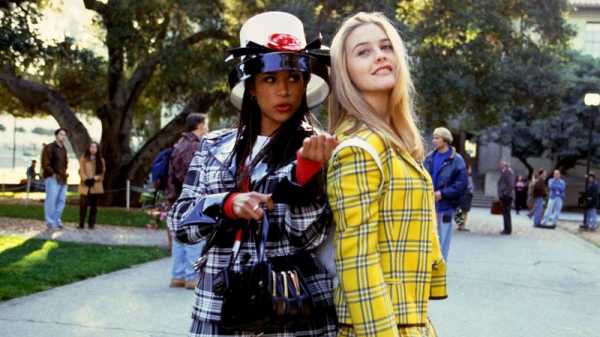
“Clueless” (1995)
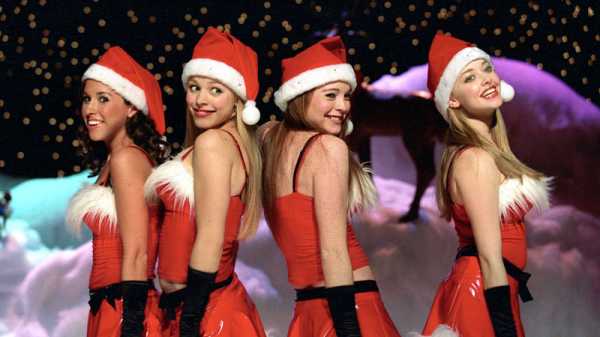
“Mean Girls” (2004)
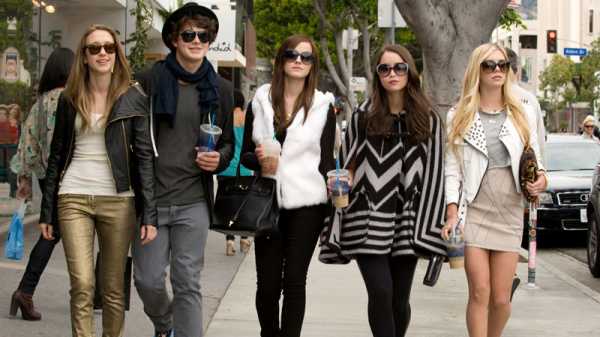
“The Bling Ring” (2013)
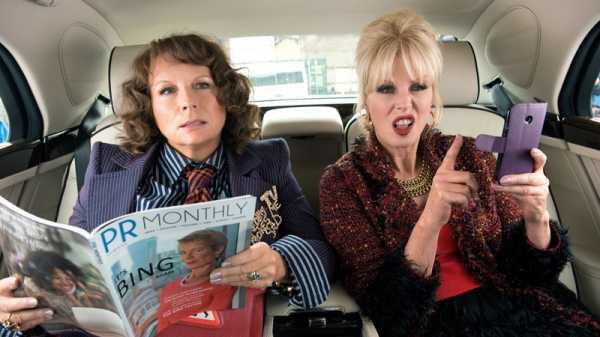
“Absolutely Fabulous: The Movie” (2016)
Veronica, as played by Ryder, begins the movie in clothing that apes the proportions of the Heathers’ outfits, albeit in more sombre tones, to match her pale skin and dark hair. As her character begins to pursue a life of crime under J.D.’s tutelage, she transitions to the deconstructed garb of the outlaw: turtlenecks, sunglasses, soft-shouldered jackets. By the end of “Heathers,” post-explosion, she is a grimy, bristly-haired urchin, half Victorian chimney sweep and half Siouxsie Sioux—the evidence of the battle she has fought and won against J.D. smeared on her body in soot.
As a teen, I felt Veronica’s triumph over her adversaries at the end of “Heathers” keenly. There was nothing cooler, in my eyes, than her stoicism in the face of her bad boyfriend’s demise. And while I didn’t exactly want to be involved in murder or suicide, I wouldn’t have minded handling my nemeses, perceived or otherwise, with a similar sangfroid.
“Veronica, you look like hell,”
Heather Duke tells her, surprised, to which Veronica responds,
“Yeah? I just got back.”
She then leaves a char-black kiss mark on Duke’s cheek, before helping herself to her scrunchie. If Hughes tended to prize a makeover moment in his movies—who could forget Ally Sheedy’s transformation from outlier weirdo to garden-variety dream girl in “The Breakfast Club”?—Veronica’s metamorphosis in “Heathers” seems to critique that impulse by turning it on its head.
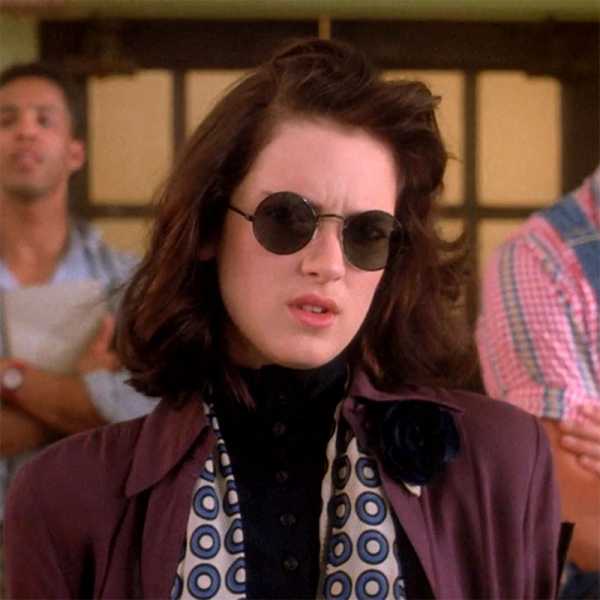
Veronica the outlaw, outfitted for a life of crime.
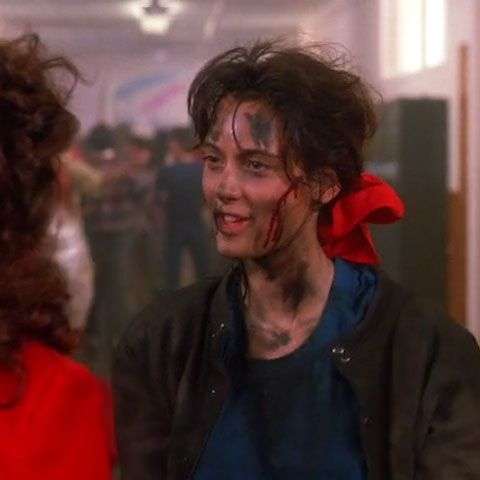
A triumphant, battle-scarred Veronica.
The thirty years since the release of “Heathers” have solidified its legacy in more ways than one. Though J.D. emerges at first as a sensitive alternative to the football-playing lunkheads of Westerberg High, it becomes increasingly clear in the course of the movie that he is a product of what we now call “toxic masculinity”—no less so than the casually brutal Kurt and Ram. J.D. is the kind of man who turns to violence because he feels that first, his mom, and later, his girlfriend, didn’t love him enough. With his trenchcoat and firearms, he can now be seen as a harbinger of the Columbine era, in which we unfortunately still very much reside. (The airing of a recent “Heathers” reboot produced by Paramount Television was repeatedly cancelled in the wake of real-life school shootings.)
The movie was ahead of its time in another respect. Two years before Bret Easton Ellis published his satirical critique of the eighties, “American Psycho,” in 1991, “Heathers” drew a prescient link between the self-satisfied, domineering Ayn Rand-ian cruelty of the Reagan era and the other side of the coin—sociopathic violence.
“Real life sucks losers dry. If you want to fuck with the eagles, you have to learn to fly,”
Veronica quotes Heather Chandler as telling her. J.D., despite his seemingly subversive ethics, ends up espousing a vicious credo that mimics the Heathers’ division of the world into the powerful and the powerless. He and the Heathers are all, in a sense, versions of Patrick Bateman, Ellis’s yuppie sociopath.
The climactic scene of “Heathers” speaks to its liminal position between the eighties and the nineties. As Veronica tussles with J.D. to dismantle the bomb he plants in the school boiler room, at one point shooting off his finger, a pep rally is under way in the gymnasium above them. The uniformed, pompom-waving cheerleaders bear more than a passing resemblance to the so-called anarchy cheerleaders who would appear, two years later, in Nirvana’s “Smells Like Teen Spirit” video. Whether wholesome or sexualized, the cheerleader has often stood for all that is adored and desired in the microcosm of the American high school. But in Nirvana’s video and in “Heathers,” too, the figure is no longer separable from the dark, sludgy energies churning in the bowels of the school.
Deconstructing the Cheerleader
In the nineties, the cheerleader—once the ultimate symbol of feminine desirability—came to embody, for many artists and filmmakers, the irony of American identity.
In the end, it is Veronica who emerges as the movie’s true hero. In her resistance to the Heathers and, later, J.D., she follows a path not just toward her own liberation but, more broadly, toward a new decade. “Heathers” is almost proto-grunge in its disdain for the Reaganite fantasy: by presenting American violence side by side with American wholesomeness, the movie dismantles the flimsy alibi the latter so often provides for the former. To watch “Heathers” as a teen-ager was to understand, maybe for the first time, that the way things are isn’t the way things should be. To watch it now, as an adult, is to remember what it was like to grasp that lesson, and to want to learn it anew.
Credits: “Heathers” (New World Pictures, 1989). The Hughesian Ending: “Sixteen Candles” (Universal Pictures, 1984), “Some Kind of Wonderful” (Paramount Pictures, 1987), “The Breakfast Club” (Universal Pictures, 1985), “Pretty in Pink” (Paramount Pictures, 1986). Hollywood High: “Fast Times at Ridgemont High” (Universal Pictures, 1982), “The Breakfast Club,” “Better Off Dead” (Warner Bros., 1985), “Pretty In Pink,” “Heathers,” “Say Anything” (20th Century Fox, 1989), “Dazed and Confused” (Gramercy Pictures, 1993), “Clueless” (Paramount Pictures, 1995), “Jawbreaker” (TriStar Pictures, 1999), “Drop Dead Gorgeous” (New Line Cinema, 1999), “Election” (Paramount Pictures, 1999), “Bring It On” (Universal Pictures, 2000), “Mean Girls” (Paramount Pictures, 2004), “Superbad” (Columbia Pictures, 2007), “Thoroughbreds” (Focus Features/Universal Pictures, 2017). Queen-Bee Fashion: “The Women” (Loew’s Inc., 1939), “Grease” (Paramount Pictures, 1978), “Heathers,” “Clueless,” “Mean Girls,” “The Bling Ring” (Merrick Morton / A24 / Everett), “Absolutely Fabulous: The Movie” (Fox Searchlight Pictures, 2016). Deconstructing the Cheerleader: “Heathers,” “Smells Like Teen Spirit” (DGC, 1991), “Twin Peaks”(CBS Television Distribution, 1990-91), “The Faculty” (Miramax Films, 1998), “American Beauty” (DreamWorks Pictures, 1999), “But I’m a Cheerleader” (Lions Gate Films, 1999), “Bring It On.”
More from the Touchstones series
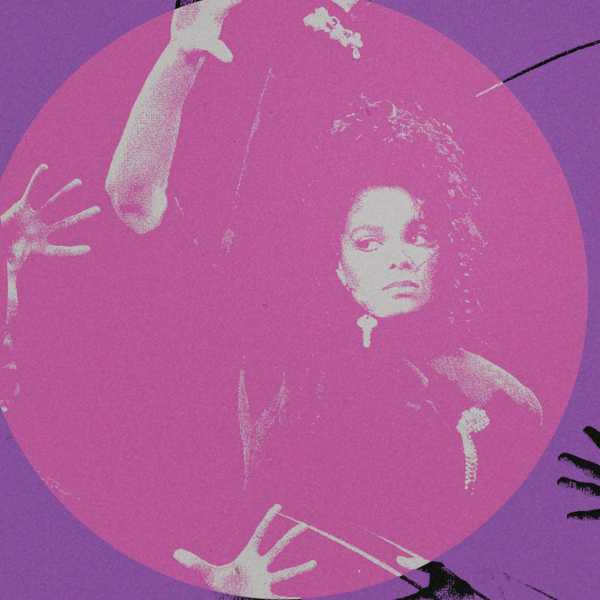
Janet Jackson’s
“Rhythm Nation 1814”
The album preached the unifying power of dance, and taught that performance could be its own kind of genius.

Nirvana’s
“Nevermind”
The 1991 album gave rise to a rock genre and captured the spirit of a generation.
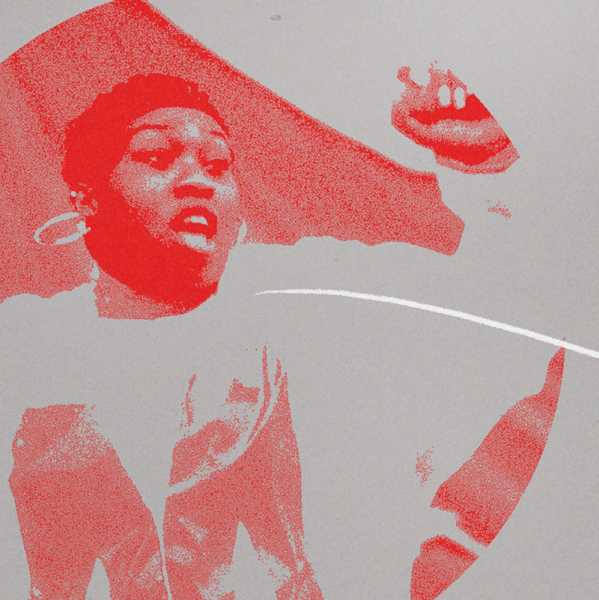
Missy Elliott’s
“Supa Dupa Fly”
The 1997 album defined a new hip-hop aesthetic and expanded the definition of rap.
Sourse: newyorker.com






